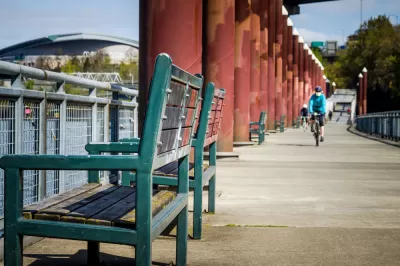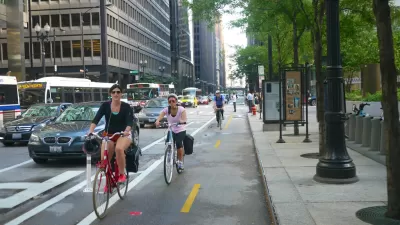"Anytime the city does something to dramatically improve streets for people and limit car access...it’s hard to take them back."

Kristian Foden-Vencil reports on the ongoing bike boom in Portland, and its likelihood of persisting beyond the pandemic.
The story is obviously focused on Portland's unique culture, where a bike boom is measured in group rides focused on Pickles, Star Trek, crossing bridges, and being naked. But, there have been more run-of-the-mill signs of biking's popularity during the pandemic:
At the height of the pandemic, the streets were so full of bikes, the city had to do something. It launched a ‘Slow Streets’ program and put plastic bollards and signs across 100 miles of streets to make them bike and pedestrian-friendly.
While an official count is "elusive," according to the article, Foden-Vencil cites Bike Portland editor Jonathan Maus to make the case that the bike boom is likely to stick around in Portland.
“Anytime the city does something to dramatically improve streets for people and limit car access...it’s hard to take them back because, guess what, people love having a healthier quieter, more humane way to get around,” Maus said.
While the Oregon Department of Transportation recently announced $55 million in funding for pedestrian and bike infrastructure, and the "Infrastructure Investment and Jobs Act" recently passed by the Senate could include big sums of money for bike infrastructure if it achieves full approval in the House, Maus also argues that it will take more than money for bikes to help significant numbers of people ditch cars for bikes—it will also take less spending on car infrastructure (an orientation that the Oregon Department of Transportation hasn't yet abandoned, despite its $55 million promise).
FULL STORY: Will the bicycling boom survive after the pandemic?

Alabama: Trump Terminates Settlements for Black Communities Harmed By Raw Sewage
Trump deemed the landmark civil rights agreement “illegal DEI and environmental justice policy.”

Planetizen Federal Action Tracker
A weekly monitor of how Trump’s orders and actions are impacting planners and planning in America.

The 120 Year Old Tiny Home Villages That Sheltered San Francisco’s Earthquake Refugees
More than a century ago, San Francisco mobilized to house thousands of residents displaced by the 1906 earthquake. Could their strategy offer a model for the present?

BLM To Rescind Public Lands Rule
The change will downgrade conservation, once again putting federal land at risk for mining and other extractive uses.

Indy Neighborhood Group Builds Temporary Multi-Use Path
Community members, aided in part by funding from the city, repurposed a vehicle lane to create a protected bike and pedestrian path for the summer season.

Congestion Pricing Drops Holland Tunnel Delays by 65 Percent
New York City’s contentious tolling program has yielded improved traffic and roughly $100 million in revenue for the MTA.
Urban Design for Planners 1: Software Tools
This six-course series explores essential urban design concepts using open source software and equips planners with the tools they need to participate fully in the urban design process.
Planning for Universal Design
Learn the tools for implementing Universal Design in planning regulations.
Clanton & Associates, Inc.
Jessamine County Fiscal Court
Institute for Housing and Urban Development Studies (IHS)
City of Grandview
Harvard GSD Executive Education
Toledo-Lucas County Plan Commissions
Salt Lake City
NYU Wagner Graduate School of Public Service





























